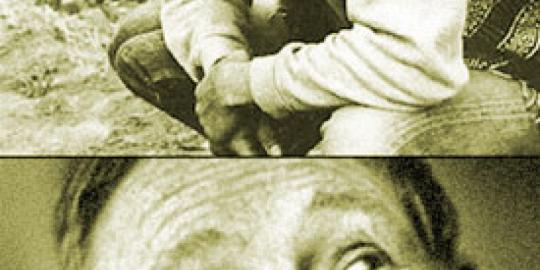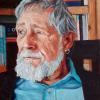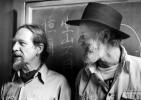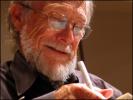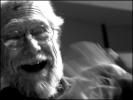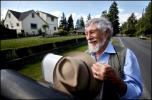Blog posts
Posts
A Hackers Manifesto, verze 4.0, kapitola 4.
By samotar, 10 January 2023
Alfred ve dvoře čili Poznámka k pražské hetero-utopii
By samotar, 10 November 2022
Trnovou korunou a tankem do srdíčka
By samotar, 2 July 2022
Hakim Bey - Informační válka
By samotar, 26 March 2022
Jean-Pierre Dupuy: Do we shape technologies, or do they shape us?
By samotar, 6 March 2022
Václav Cílek: Záhada zpívající houby
By samotar, 15 February 2022
Guy Debord - Teorie dérive
By samotar, 21 January 2022
Jack Burnham – Systémová estetika
By samotar, 19 November 2021
Poznámka pod čarou k výstavě Handa Gote: Věc, nástroj, čas, fetiš, hygiena, tabu
By samotar, 13 July 2021
Rána po ránech
By samotar, 23 May 2021
Na dohled od bronzového jezdce
By samotar, 4 March 2021
Z archivu:Mlha - ticho - temnota a bílé díry
By samotar, 7 October 2020
Zarchivu: Hůlna-kejdže
By samotar, 7 September 2020
Center for Land Use Interpretation
By samotar, 18 June 2020
Dawn Chorus Day - zvuky za svítání
By samotar, 30 April 2020
Z archivu: Bílé Břehy 2012 a Liběchov 2011
By , 3 April 2020
Z archivu: Krzysztof Wodiczko v DOXU
By samotar, 26 March 2020
GARY SNYDER: WRITERS AND THE WAR AGAINST NATURE
By samotar, 20 March 2020
Podoby domova: hnízda, nory, doupata, pavučiny, domestikace a ekologie
By samotar, 17 March 2020
Michel Serres: Transdisciplinarity as Relative Exteriority
By samotar, 5 November 2019
Pavel Ctibor: Sahat zakázáno
By samotar, 22 September 2019
Emmanuel Lévinas: HEIDEGGER, GAGARIN A MY
By samotar, 19 September 2019
Atmosférické poruchy / Atmospheric Disturbances - Ustí nad Labem
By samotar, 13 September 2019
Erkka Laininen: A Radical Vision of the Future School
By samotar, 10 August 2019
Anton Pannekoek: The Destruction of Nature (1909)
By samotar, 21 July 2019
Co padá shůry - světlo, pelyněk, oheň a šrot
By samotar, 30 December 2018
2000 slov v čase klimatických změn - manifest
By samotar, 2 November 2018
Vladimír Úlehla, sucho, geoinženýrství, endokrinologie, ekologie a Josef Charvát
By samotář, 22 September 2018
Lukáš Likavčan: Thermodynamics of Necrocracy - SUVs, entropy, and contingency management
By samotar, 20 July 2018
Tajemství spolupráce: Miloš Šejn
By samotar, 27 June 2018
Invisible Images (Your Pictures Are Looking at You) Trevor Paglen
By samotar, 2 June 2018
KŘEST KNIHY KRAJINA V POZORU: THE LANDSCAPE IN FOCUS.
By samotar, 18 May 2018
Případ zchudlé planety:Vojtěch Kotecký
By samotar, 22 April 2018
Rozhovor na Vltavě: Jak umění reaguje na dobu antropocénu?
By samotar, 10 March 2018
Skolt Sámi Path to Climate Change Resilience
By samotar, 10 December 2017
Brian Holmes: Driving the Golden Spike - The Aesthetics of Anthropocene Public Space
By samotar, 22 November 2017
Ohlédnutí/Revisited Soundworm Gathering
By samotař, 9 October 2017
Kleté krajiny
By samotar, 7 October 2017
Kinterova Jednotka a postnatura
By samotař, 15 September 2017
Ruiny-Černý trojúhelník a Koudelkův pohyb v saturnských kruzích
By samotar, 13 July 2017
Upsych316a Universal Psychiatric Church
By Samotar, 6 July 2017
Miloš Vojtěchovský: Krátká rozprava o místě z roku 1994
By milos, 31 May 2017
Za teorií poznání (radostný nekrolog), Bohuslav Blažek
By miloš vojtěchovský, 9 April 2017
On the Transmutation of Species
By miloš vojtěchovský, 27 March 2017
Gustav Metzger: Poznámky ke krizi v technologickém umění
By samotař, 2 March 2017
CYBERPOSITIVE, Sadie Plant a Nick Land
By samotař, 2 March 2017
Ivan Illich: Ticho jako obecní statek
By samotař, 18 February 2017
Dialog o primitivismu – Lawrence Jarach a John Zerzan
By samotar, 29 December 2016
Thomas Berry:Ekozoická éra
By samotař, 8 December 2016
Jason W. Moore: Name the System! Anthropocenes & the Capitalocene Alternative
By miloš vojtěchovský, 24 November 2016
Michel Serres: Revisiting The Natural Contract
By samotař, 11 November 2016
Best a Basta době uhelné
By samotař, 31 October 2016
Epifanie, krajina a poslední člověk/Epiphany, Landscape and Last Man
By Samotar, 20 October 2016
Doba kamenná - (Ein, Eisen, Wittgen, Frankenstein), doba plastová a temná mineralogie
By samotař, 4 October 2016
Hledání hlasu řeky Bíliny
By samotař, 23 September 2016
Harrisons: A MANIFESTO FOR THE 21ST CENTURY
By , 19 September 2016
T.J. Demos: Anthropocene, Capitalocene, Gynocene: The Many Names of Resistance
By , 11 September 2016
Bratrstvo
By samotař, 1 September 2016
Neptunismus a plutonismus na vyhaslé sopce Bořeň
By , 14 August 2016
Murray Bookchin: Toward an Ecological Society/ K ekologické společnosti (1974)
By samotař, 31 July 2016
Metafory, endofyzika, manželé Themersonovi a Gordon Pask
By samotař, 15 July 2016
Anima Mundi Revisited
By miloš vojtěchovský, 28 June 2016
Simon A. Levin: The Evolution of Ecology
By samotař, 21 June 2016
Anna Remešová: Je možné představit si změnu?
By samotar, 20 June 2016
Jan Hloušek: Uranové město
By samotař, 31 May 2016
Josef Šmajs: Složí lidstvo zkoušku své racionální dospělosti?
By samotař, 20 May 2016
Manifest The Dark Mountain Project
By Samotar, 3 May 2016
Pokus o popis jednoho zápasu
By samotar, 29 April 2016
Václav Cílek: Antropocén – velké zrychlení světa
By Slawomír Uher, 23 April 2016
Nothing worse or better can happen
By Ewa Jacobsson, 5 April 2016
Real Reason we Can’t Stop Global Warming: Saskia Sassen
By , 18 March 2016
The Political Economy of the Cultural Commons and the Nature of Sustainable Wealth
By samotar, 12 March 2016
Jared Diamond - Easter's End
By , 21 February 2016
Felix Guattari - Three Ecologies (part 1)
By , 19 February 2016
W. H. Auden: Journey to Iceland
By , 9 February 2016
Jussi Parikka: The Earth
By Slawomír Uher, 8 February 2016
Brian Holmes: Extradisciplinary Investigations. Towards a New Critique of Institutions
By Stanislaw, 7 February 2016
Co číhá za humny? neboli revoluce přítomnosti
By Miloš Vojtěchovský, 31 January 2016
Podivuhodný osud polárníka a malíře Julia Payera
By , 23 January 2016
Red Sky: The Eschatology of Trans
By Miloš Vojtěchovský, 19 January 2016
#AKCELERACIONISTICKÝ MANIFEST (14. května 2013)
By samotar, 7 January 2016
The Forgotten Space: Notes for a Film
By , 7 January 2016
Rise and Fall of the Herring Towns:Impacts of Climate and Human Teleconnections
By , 25 December 2015
Hlubinná, temná, světlá i povrchová ekologie světa
By , 22 December 2015
Three short movies: Baroque Duchcov, New Lakes of Mostecko and Lignite Clouds
By Michal Kindernay, 21 December 2015
Lenka Dolanová: Umění mediální ekologie
By , 21 December 2015
Towards an Anti-atlas of Borders
By , 20 December 2015
Pavel Mrkus - KINESIS, instalace Nejsvětější Salvátor
By Miloš Vojtěchovský, 6 December 2015
Tváře/Faces bez hranic/Sans Frontiers
By Miloš Vojtěchovský, 29 November 2015
Josef Šmajs: Ústava Země/A Constitution for the Earth
By Samotar, 28 November 2015
John Jordan: The Work of Art (and Activism) in the Age of the Anthropocene
By Samotar, 23 November 2015
Humoreska: kočky, koulení, hroby a špatná muška prince Josefa Saského
By Samotar, 13 November 2015
Rozhovor:Před věčným nic se katalogy nesčítají
By Samotar, 11 November 2015
Lecture by Dustin Breiting and Vít Bohal on Anthropocene
By Samotar, 8 November 2015
Antropocén a mocné žblunknutí/Anthropocene and the Mighty Plop
By Samotar, 2 November 2015
Rory Rowan:Extinction as Usual?Geo-Social Futures and Left Optimism
By Samotar, 27 October 2015
Pavel Klusák: Budoucnost smutné krajiny/The Future of a Sad Region
By ll, 19 October 2015
Na Zemi vzhůru nohama
By Alena Kotzmannová, 17 October 2015
Upside-down on Earth
By Alena Kotzmannová, 17 October 2015
Thomas Hylland Eriksen: What’s wrong with the Global North and the Global South?
By Samotar, 17 October 2015
Nýey and Borealis: Sonic Topologies by Nicolas Perret & Silvia Ploner
By Samotar, 12 October 2015
Images from Finnmark (Living Through the Landscape)
By Nicholas Norton, 12 October 2015
Bruno Latour: Love Your Monsters, Why We Must Care for Our Technologies As We Do Our Children
By John Dee, 11 October 2015
Temné objekty k obdivu: Edward Burtynsky, Mitch Epstein, Alex Maclean, Liam Young
By Samotar 10 October 2015, 10 October 2015
Czech Radio on Frontiers of Solitude
By Samotar, 10 October 2015
Beyond Time: orka, orka, orka, nečas, nečas, nečas
By Samotar, 10 October 2015
Langewiese and Newt or walking to Dlouhá louka
By Michal Kindernay, 7 October 2015
Notice in the Norwegian newspaper „Altaposten“
By Nicholas Norton, 5 October 2015
Interview with Ivar Smedstad
By Nicholas Norton, 5 October 2015
Iceland Expedition, Part 2
By Julia Martin, 4 October 2015
Closing at the Osek Monastery
By Michal Kindernay, 3 October 2015
Iceland Expedition, Part 1
By Julia Martin, 3 October 2015
Finnmarka a kopce / The Hills of Finnmark
By Vladimír Merta, 2 October 2015
Od kláštera Osek na Selesiovu výšinu, k Lomu, Libkovicům, Hrdlovce a zpět/From The Osek Cloister to Lom and back
By Samotar, 27 September 2015
Sápmelažžat Picnic and the Exploration of the Sami Lands and Culture
By Vladimir, 27 September 2015
Gardens of the Osek Monastery/Zahrady oseckého kláštera
By ll, 27 September 2015
Workshop with Radek Mikuláš/Dílna s Radkem Mikulášem
By Samotářka Dagmar, 26 September 2015
Czech Radio Interview Jan Klápště, Ivan Plicka and mayor of Horní Jiřetín Vladimír Buřt
By ll, 25 September 2015
Bořeň, zvuk a HNP/Bořeň, sound and Gross National Product
By Samotar, 25 September 2015
Já, Doly, Dolly a zemský ráj
By Samotar, 23 September 2015
Up to the Ore Mountains
By Michal, Dagmar a Helena Samotáři , 22 September 2015
Václav Cílek and the Sacred Landscape
By Samotář Michal, 22 September 2015
Picnic at the Ledvice waste pond
By Samotar, 19 September 2015
Above Jezeří Castle
By Samotar, 19 September 2015
Cancerous Land, part 3
By Tamás Sajó, 18 September 2015
Ledvice coal preparation plant
By Dominik Žižka, 18 September 2015
pod hladinou
By Dominik Žižka, 18 September 2015
Cancerous Land, part 2
By Tamás Sajó, 17 September 2015
Cancerous Land, part 1
By Tamás Sajó, 16 September 2015
Offroad trip
By Dominik Žižka, 16 September 2015
Ekologické limity a nutnost jejich prolomení
By Miloš Vojtěchovský, 16 September 2015
Lignite Clouds Sound Workshop: Days I and II
By Samotar, 15 September 2015
Recollection of Jezeří/Eisenberg Arboretum workshop
By Samotar, 14 September 2015
Walk from Mariánské Radčice
By Michal Kindernay, 12 September 2015
Mariánské Radčice and Libkovice
By Samotar, 11 September 2015
Tušimice II and The Vicarage, or the Parsonage at Mariánské Radčice
By Samotar, 10 September 2015
Most - Lake, Fish, algae bloom
By Samotar, 8 September 2015
Monday: Bílina open pit excursion
By Samotar, 7 September 2015
Duchcov II. - past and tomorrow
By Samotar, 6 September 2015
Duchcov II.
By Samotar, 6 September 2015
Arrival at Duchcov I.
By Samotar, 6 September 2015
Poznámka k havárii rypadla KU 300 (K severu 1)
By Samotar, 19 August 2015
GARY SNYDER: WRITERS AND THE WAR AGAINST NATURE
Published in the Journal Resurgence and Ecologist
A Far Cry from Christmas, Issue 239, November/December 2006,
Google Czech translation is available as well:
"vyrostl v námořním severozápadním Pacifiku, na farmě na sever od Seattlu, kde jsme drželi slepici hejno, měli malý sadu a dělali dojnice. Moji strýci byli logáři, obchodní námořníci nebo rybáři. Po škole, kde jsem studoval antropologii, literaturu a východoasijskou kulturu, neměl jsem jinou možnost než vrátit se do práce v lese a na moři. V pozdních padesátých letech jsem pracovala ve strojovně na ropném tankeru s americkou vlajkou, která mě najala z přístavu Yokohama. Byl jsem členem Národní námořní unie a měl moje námořní doklady a nebylo těžké si vyřídit práci v téměř každém přístavu světa."
https://cs.mindfulnessreview.com/writers-war-against-nature-1073
WRITERS AND THE WAR AGAINST NATURE
I grew up in the maritime Pacific Northwest, on a farm north of Seattle where we kept a hen flock, had a small orchard, and tended dairy cows. My uncles were loggers, merchant seamen or fishermen.
After college, where I studied anthropology, literature and East Asian culture, I had no choice but to go back to working in the woods and at sea. In the late fifties I spent nine months working in the engine room on an American-flag oil tanker that hired me out of the port of Yokohama. I was a member of the National Maritime Union and had my seaman’s papers, and it wasn’t hard to pick up a job in almost any port of the world. That ship kept me at sea for a continuous nine months. Two things touched me deeply on that job: one was the stars, night after night, at every latitude, including way below the equator. With my little star book and red-beam flashlight I mastered the constellations of the southern hemisphere. The other was getting to know the birds of the ocean. I loved watching the albatross – a few of those huge graceful birds would always be cruising along behind our ship, trailing the wake for bits of food. I learned that a wandering albatross (of the southern hemisphere) might fly a million miles in one lifetime, and that it takes a pair of them almost a year to raise one chick. Night and day, they always followed us, and if they ever slept it seems it was on the wing.
In January 2005, a study was released describing the sudden decline of albatross numbers worldwide. It even prompted an editorial in the New York Times. Their sharp decline is attributed to much death by drowning. The long-line fishing boats lay out lines with bait and hooks that go miles back, dragging just below the surface. An albatross will go for the bait, get hooked and be pulled down to drown. As many as 100,000 a year are estimated to perish in this way, enough to threaten the survival of the species if it keeps up. What have the albatross, “distinguished strangers who have come down to us from another world”, ever done to us? The editorial concludes, “The long-line fishing fleet is over-harvesting the air as well as the sea.”
Out on the South Pacific in 1958, watching the soaring albatrosses from the stern of a ship, I could never have guessed that their lives would be threatened by industrial societies, turning them into ‘collateral damage’ of the affluent appetite for ahi, maguro – tuna species (my own taste too) – yet this is just a tiny, almost insignificant example of the long reach of the globalised economy and the consumer society into the wild Earth’s remote places. A recent book on global logging and deforestation is titled Strangely Like War. What is happening now to nature worldwide, plant life and wildlife, ocean, grassland, forest, savannah, desert – all spaces and habitat – the non-human realm of watersheds and ecosystems with all their members, can be likened to a war against nature.
Although human beings have interacted with nature – both cultivated and wild – for millennia, and sometimes destructively so, it was never quite like war. It has now become disconcertingly so, and the active defence of nature has been joined by a few artists and writers who have entered the fight on ‘the wild side’ along with subsistence peoples, indigenous spiritual leaders, many courageous scientists, and conservationists and environmentalists worldwide.
There is a tame and also a wild side to the human mind. The tame side, like a farmer’s field, has been disciplined and cultivated to produce a desired yield. It is useful, but limited. The wild side is larger, deeper, more complex, and though it cannot be fully known, it can be explored. The explorers of the wild mind are often writers and artists. The “poetic imagination” of which William Blake so eloquently spoke is the territory of wild mind. It has landscapes and creatures within it that will surprise us; it can refresh us and scare us. It reflects the larger truth of our ancient selves, both animal and spiritual.
The French anthropologist Claude Lévi-Strauss said something like “Art survives within modern civilisation rather like little islands of wilderness saved to show us where we came from.” Someone else said that what makes writing good is the wildness in it. The wildness gives heart, courage, love, spirit, danger, compassion, skill, fierceness and sweetness – all at once – to language. From ancient times, storytellers, poets and dramatists have presented the world in all its fullness: plants, animals, men and women, changing shape, speaking multiple languages, inter-marrying, travelling to the sky and under the Earth. The great myths and folktales of human magic and nature’s power were our school for ten thousand years. Whether they know it or not, even modern writers draw strength from the wild side.
How can artists and writers manage to join in the defence of the planet and wild nature? Writers and artists by their very work ‘bear witness’. They don’t wield financial, governmental or military power. However, at the outset they were given, as in fairy tales, two ‘magic gifts’: one is the ‘Mirror of Truth’. Whatever they hold this mirror up to is shown in its actual form, and the truth must come out. May we use that mirror well! The second is a ‘Heart of Compassion’ , which is to say the ability to feel and know the pains and delights of other people, and to weave that feeling into their art. For some this compassion can extend to all creatures and to the world itself. In a way nature even borrows the voices of some writers and artists. Anciently this was a shamanistic role where the singer, dancer or storyteller embodied a force, appearing as a bear dancer or a crane dancer, and became one with a spirit or creature. Today, such a role is played by the writer who finds her- or himself a spokesperson for non-human entities, communicating to the human realm through dance or song. This could be called ‘speaking on behalf of nature’ in the old way.
Song, story and dance are fundamental to all later ‘civilised’ literature. In archaic times these were unified in dramatic performance, back when drama and religious ceremony were still one. They are reunited today in the highest and greatest of performance arts – the grand scale of European opera, the height of ballet, the spare and disciplined elegance of Japanese Noh theatre, the grand and almost timeless dance and story of Indonesian gamelan, the wit and hardiness of Bertolt Brecht’s plays, or the fierce and stunningly beautiful intensity of Korean p’ansori performance. Performance is of key importance because this phenomenal world and all life is of itself “not a book, but a performance”. I will say more about performance a little farther on.
For a writer or an artist to become an advocate for nature, he or she must first stumble into some connection to that vast world of energies and ecologies. Because I was brought up in a remote rural district, instead of having other children to play with I had to entertain myself by exploring the forest surrounding our farm, observing the dozens of bird species and occasional deer, fox or bobcat; sometimes hunting, sometimes gathering plants that I could sell to herb-buyers for a few pennies, and camping out alone for several days at a time. Heavy logging was going on in the nearby hills. Even as a boy I was deeply troubled by the destruction of the forests and the careless way that hunting – of both waterfowl and deer – was conducted.
At fifteen I got into the higher mountains of the Cascade range in Washington State, starting with the ridges and high meadows around the snow-covered volcano called Mount St. Helens, or Luwit, a 3,000-metre peak just north of the Columbia river. Here is what I discovered back then, and finally chose to write about in my recent book Danger on Peaks.
Climbing the Mountain
Reaching the summit, I thought – west coast snowpeaks are too much! They are too far above the surrounding lands, there is a break between, they are in a different world. If you want to get a view of the world you live in, climb a little rocky mountain with a neat small peak. The big snowpeaks pierce the realm of clouds and cranes, rest in the zone of five-coloured banners and writhing crackling dragons in veils of ragged mist and frost-crystals, of pure transparency in blue.
Mount St. Helens’ summit is smooth and broad, a place to nap, to sit and write, watch what’s higher in the sky, or do a little dance. Whatever the numbers say, snowpeaks are always far higher than the highest airplanes ever get. I made my petition to the perfect shapely mountain, “Please help this life.” When I tried to look over and down to the world below, there was nothing there.
And then we grouped up to descend. The afternoon snow was perfect for glissade, and leaning on our stocks we slid and skid between cracks and thumps into soft snow, dodged lava slabs, got into the open snowfield slopes and almost flew to the soft pumice slopes below. Coming down is so fast – still high we walked the three-mile dirt road back to the lake.
Atomic Dawn
The day I first climbed Mount St. Helens was August 13, 1945. Spirit Lake was far from the cities of the valley, and news came slow. Though the first atomic bomb was dropped on Hiroshima on August 6th, and the second dropped on Nagasaki on August 9th, photographs didn’t appear in the Portland Oregonian until August 12. Those papers must have been driven in to Spirit Lake on the 13th. Early in the morning of the 14th I walked over to the lodge to check the bulletin board. There were whole pages of the paper pinned up: photos of a blasted city from the air, the estimate of 150,000 dead in Hiroshima alone, the American scientist quoted saying “nothing will grow there again for seventy years.” The morning sun on my shoulders, the fir forest smell and the big tree shadows; my feet in thin moccasins feeling the ground, and my heart still one with the snowpeak mountain at my back. Horrified, blaming scientists and politicians and the governments of the world, I swore a vow to myself something like “By the purity and beauty and permanence of Mount St. Helens, I swear I will fight against this cruel destructive power and those who would seek to use it, for all my life.”
The statement in that 1945 newspaper saying that nature would be blighted for decades to come outraged me almost as much as the destruction of innocent human life. I was already a youthful conservationist/environmentalist, and after that I went on to be active in the anti-war movement as a student, and struggled against the use and proliferation of nuclear weapons. At the time it seemed as though these efforts were naive and hopeless, but we persevered.
During my university years I was studying the philosophies and religions of the world. I learned that the most important single ethical teaching of the Buddhist tradition is Ahimsa, nonviolence towards all of nature. This seemed absolutely right to me. In the Abrahamic religions, “Thou shalt not kill” applies only to human beings. In socialist thought as well, human beings are all-important, and with the ‘labour theory of value’ it is as though organic nature contributes nothing of worth – later it came to me: “Green plants doing photosynthesis are the ultimate working class.” Nature creates the first level of value, labour the second.
Then I read translations of Buddhist texts from India and China. The Dao De Jing and the Zhuang-zi texts helped broaden my view. I read the Lún y? – the Confucian Analects – and saw how the Master called for ‘etiquette’ in regard to nature, as well as human society. These studies brought me to the thought that almost all of later ‘high civilisation’ has been a type of social organisation that alienates humans from their own biological and spiritual heritage.
While I was labouring in the forests most of my fellow loggers were Native Americans of the Wasco and Wishram tribes of Eastern Oregon. From them I learned that it was possible to be a hunter and a fisherman with a deep spiritual attitude of gratitude and nonviolence.
Eventually I re-entered college as a graduate student in East Asian Languages at the University of California at Berkeley, and finally got a chance to go to East Asia. I lived for a while in a Zen Practice Hall in Kyoto, Japan and studied with a Zen teacher in the Rinzai (Chinese Linji) tradition. I took the precepts under my teacher, who told me, “Of all the precepts, the First Precept is most important and contains the others: Ahimsa, Non-harming, Cause the Least Possible Harm.” To live with that precept is a challenge – he once said to me, “How do you not harm a fence? How would you save a ghost?”
I lived in Japan for ten years, partly in the monastery but also in my own little house, and supported myself by teaching English conversation to Japanese company people. I asked my adult students, “Why are you so intent on learning English?” They answered, “Because we intend to extend our economic influence worldwide, and English is the international language.” I didn’t take them seriously. Today that company, Matsushita Electric, is worldwide.
In my spare time I hiked in the local mountains, studied East Asian plants and birds, and started seriously reading scientific books on ecology and biology. All those essays analysing food chains and food webs – this was a science, I realised, dealing with energy-exchange and the natural hierarchies of various living systems. “When energy passes through a system it tends to organise that system,” someone wrote. It finally came to me that this was about eating each other – almost as a sacrament. I wrote my first truly ecological poem, which explores the essential qualities of human foods:
The Song of the Taste
Eating the living germs of grasses
Eating the ova of large birds
the fleshy sweetness packed around
the sperm of swaying trees
The muscles of the flanks and thighs of
soft-voiced cows
the bounce in the lamb’s leap
the swish in the ox’s tail
Eating roots grown swoll
inside the soil.
Drawing on life of living
clustered points of light spun
out of space
hidden in the grape.
Eating each other’s seed
eating
ah, each other.
Kissing the lover in the mouth of bread:
lip to lip.
This innocently celebratory poem went straight to the question of conflict between the ethics of ahimsa and the necessary lives of indigenous peoples and Native Americans I had known. They still practise ceremonies of gratitude, and are careful not to present themselves as superior to other life forms. Ahimsa taken too literally leaves out the life of the world, and makes the rabbit virtuous but the hawk somehow evil… People who must fish and hunt to live can enter into the process with gratitude and care, and no arrogant assumptions of human privilege. This cannot come from ‘thinking about’ nature; it must come from a being within nature.
There are plenty of people of influence and authority in the churches, in industry, the universities, and high in government who still like to describe nature as “red in tooth and claw” (a line of Alfred Tennyson’s) – a fundamental misunderstanding – and use it as part of the justification for the war against nature.
I would now like to propose some simple definitions. The English word ‘nature’ is from Latin natura, ‘birth, constitution, character, course of things’ – ultimately from nasci, ‘to be born’. It connects with the root nat which is connected with birth, so we have ‘nation’, ‘natal’, and ‘native’. The Chinese word for ‘nature’ is zi-ran, meaning ‘self-thus’. Although in common English and American usage ‘nature’ is sometimes used to mean ‘the outdoors’ and set in opposition to the realm of development, the word ‘nature’ is best used in its specific scientific sense, referring to the physical universe and its rules, the ‘laws of nature’. In this use it is equivalent to the Greek physis. In other words, ‘nature’ means ‘everything’. The agricultural, the urban, the wild mountains and forests and the many stars in the sky are all equally phenomena. ‘Nature’ is our reality.
Cities and agricultural lands however are not wild. ‘Wild’ is a valuable word. It is a term for the free and independent process of nature. A wilderness is a place where wild process dominates and human impact is minimal. Wilderness need not be a place that was never touched by humans, but simply a place where wild process has ruled for some decades.
The wild is self-creating, self-maintaining, self-propagating, self-reliant, self-actualising, and it has no ‘self’. It is perhaps the same as what East Asian philosophers call the Dao. The human mind, imagination, and even natural human language can also thus be called wild. The human body itself with its circulation, respiration and digestion is wild. In these senses ‘wild’ is a word for the intrinsic, non-theistic, forever-changing natural order.
‘Ecology’, another key word, has Greek oikos as its main root, with the simple meaning of ‘household’. It referred originally to the study of biological interrelationships and the flow of energy through organisms and inorganic matter. In recent years it has become a synonym for ‘outdoor nature’ in popular usage. I prefer to use it closer to the original meaning, with an emphasis on the dynamics of relationship in wild natural process. (I presented these definitions more fully in my 1990 book The Practice of the Wild.)
The field of ecological study embraces questions of population rise and fall, plant and animal succession, predator-prey relationships, competition and co-operation, feeding levels, and the flow of energy through ecosystems – and this is just the beginning. I have learned a great deal in my work on the forest issues of western North America over the last few years from people in the field of forest ecology (sometimes with the help of my older son, Kai Snyder, who is in this field). I have come to better understand the dynamism of natural systems, the continuous role of disturbance and the unremitting effects of climatic fluctuations. The ‘human ecology’ aspect of the ecological sciences helps us understand the role that human beings have played as members of wild nature, and how the interconnectedness of the entire planet requires that we take care of this place that we live in, and which lives in us. It tells us what ‘sustainable’ means, and that modern humans must again become members of the organic world.
The organic life of the planet has maintained itself, constantly changing, and has gone through and recovered from several enormous catastrophic events over hundreds of millions of years. Now we are realising that the human impact on air, water, wildlife, soil and plant life is so extreme that there are species becoming extinct, water dangerous to even touch, mountains with mudslides but no trees, and soil that won’t grow food without the continuous subsidy provided by petroleum. As we learned over time to positively work for peace to head off the possibilities of war, so now we must work for sustainable biological practices and a faith that includes wild nature, if we are to reverse the prospect of continuously dwindling resources and rising human populations.
One can ask what it might take to have an agriculture that does not degrade the soils, a fishery that does not deplete the ocean, a forestry that keeps watersheds and ecosystems intact, population policies that respect human sexuality and personality while holding numbers down, and energy policies that do not set off fierce little wars. These are the key questions.
Many of our leaders assume that the track we’re on will go forever and nobody will learn much; politics as usual. It’s the same old engineering, business and bureaucracy message with its lank rhetoric of data and management. Or, when the talk turns to ‘sustainability’ the focus is on a limited ecological-engineering model that might guarantee a specific resource (such as grass, water, or trees) for a while longer but lacks the vision to imagine the health of the whole planet. The ethical position that would accord intrinsic value to non-human nature, and would see human beings as involved in moral as well as practical choices in regard to the natural world makes all the difference.
“As … a dewdrop, a bubble, a cloud, a flash of lightning, view all created things.” Thus ends the Diamond Sutra, reminding us of irreducible impermanence. Sustainability cannot mean some kind of permanence. A waggish commentary says, “Sustainability is a physical impossibility. But it is a very nice sentiment.” The quest for permanence has always led us astray – whether building stone castles, Great Walls, Pyramids for the Kings, great navies, giant cathedrals to ease us toward heaven, or cold-war-scale weapons systems guaranteeing ‘mutually assured destruction’. We must live with change, like a bird on the wing, and, doing so, let all the other beings live on, too. Not permanence, but ‘living in harmony with the Way’.
The albatrosses, all sixteen species of them, are companions with us on Earth, sailing on their own way, of no use to us humans, and we should be no use to them. They can be friends at a distance, fellow creatures in the stream of evolution. This is fundamental etiquette. Legislation from the governments regarding fisheries in the sea or deforestation in the mountains would help enormously.
So, back to those key questions: what would it take? We know that science and the arts can be allies. We need far more women in politics. We need a religious view that embraces nature and does not fear science; business leaders who know and accept ecological and spiritual limits; political leaders who have spent time working in schools, factories or farms and who still write poems. We need intellectual and academic leaders who have studied both history and ecology and like to dance and cook. We need poets and novelists who pay no attention to literary critics. But what we ultimately need most is human beings who love the world.
One time in Alaska a young Koyukon Indian college student asked me, “If we humans have made such good use of animals, eating them, singing about them, drawing them, riding them and dreaming about them, what do they get back from us?” I thought it an excellent question, directly on the point of etiquette and propriety, and putting it from the animals’ side. I told her, “The Ainu say that the deer, salmon and bear like our music and are fascinated by our languages. So we sing to the fish or the game, speak words to them, say grace. We do ceremonies and rituals. Performance is currency in the deep world’s gift economy. The ‘deep world’ is of course the thousand-million-year old world of rock, soil, water, air and all living beings, all acting through their roles. ‘Currency’ is what you pay your debt with. We all receive, every day, the gifts of the Deep World, from the air we breathe to the food we eat. How do we repay that gift? Performance. A song for your supper.”
I went on to tell her that I felt that non-human nature is basically well-inclined toward humanity and only wishes modern people were more reciprocal, not so bloody. The animals are drawn to us, they see us as good musicians, and they think we have cute ears. The human contribution to the planetary ecology might be our entertaining eccentricity, our skills as musicians and performers, our awe-inspiring dignity as ritualists and solemn ceremonialists – because that is what seems to delight the watching wild world.
Gift economy: what’s that? That might be another perspective on the meaning of ecology. We are living, so to speak, in the midst of a great potluck feast to which we are all the invited guests, and we also are eventually the meal. The Ainu of Hokkaido, when they had venison for dinner, sang songs aloud to the deer spirits who were hanging about waiting for the performance. The deer visit human beings so that they may hear some songs. In Buddhist spiritual ecology, the first thing to give up is your ego. The ancient Vedic philosophers said that the gods like sacrifices, but of all sacrifices that which they most appreciate is your ego. This critical little point is the foundation of yogic and Buddhist practice. Zen philosopher Dogen famously said, “We study the self to forget the self. When you forget the self you become one with the ten thousand things.” (There is only one offering that is greater than the ego, and that is ‘enlightenment’ itself.)
The being who is willing to give away her or his enlightenment is called a Bodhisattva. In some of the Polynesian societies the Big Person, the most respected and powerful figure in the village, was the one who had nothing – whatever gift came to him or her was promptly given away again. This is the real heart of a gift economy, the economy that would save, not devour, the world. (Gandhi once said, “For greed, all of nature is insufficient.”) Art takes nothing from the world: it is a gift and an exchange. It leaves the world nourished.
Poems, novels, plays, with their great deep minds of story, awaken the Heart of Compassion. And so they confound the economic markets, rattle the empires, and open us up to the actually existing human and non-human world. Performance is art in motion; in the moment; both enactment and embodiment. This is exactly what nature herself is.
Soaring just over the sea-foam
riding the wind of the endless waves
albatross, out there, way
away, a far cry
down from the sky
And when humanity is laid out like coal
somewhere some earnest geologist
will note them in his notebook.
Gary Snyder “The Politicians,” The Back Country
Gary Snyder is an American poet, writer, and environmental activist.
